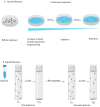Synaptic Mechanisms of Ethanol Tolerance and Neuroplasticity: Insights from Invertebrate Models
- PMID: 38999947
- PMCID: PMC11241699
- DOI: 10.3390/ijms25136838
Synaptic Mechanisms of Ethanol Tolerance and Neuroplasticity: Insights from Invertebrate Models
Abstract
Alcohol tolerance is a neuroadaptive response that leads to a reduction in the effects of alcohol caused by previous exposure. Tolerance plays a critical role in the development of alcohol use disorder (AUD) because it leads to the escalation of drinking and dependence. Understanding the molecular mechanisms underlying alcohol tolerance is therefore important for the development of effective therapeutics and for understanding addiction in general. This review explores the molecular basis of alcohol tolerance in invertebrate models, Drosophila and C. elegans, focusing on synaptic transmission. Both organisms exhibit biphasic responses to ethanol and develop tolerance similar to that of mammals. Furthermore, the availability of several genetic tools makes them a great candidate to study the molecular basis of ethanol response. Studies in invertebrate models show that tolerance involves conserved changes in the neurotransmitter systems, ion channels, and synaptic proteins. These neuroadaptive changes lead to a change in neuronal excitability, most likely to compensate for the enhanced inhibition by ethanol.
Keywords: AUD; C. elegans; Drosophila; alcohol tolerance; invertebrates; neuroplasticity; neurotransmission.
Conflict of interest statement
The authors declare no conflicts of interest. The funders had no role in the design of the study; in the collection, analyses, or interpretation of data; in the writing of the manuscript; or in the decision to publish the results.
Figures


Similar articles
-
Alcohol Sanitizer.2023 Aug 9. In: StatPearls [Internet]. Treasure Island (FL): StatPearls Publishing; 2025 Jan–. 2023 Aug 9. In: StatPearls [Internet]. Treasure Island (FL): StatPearls Publishing; 2025 Jan–. PMID: 30020626 Free Books & Documents.
-
Managed alcohol as a harm reduction intervention for alcohol addiction in populations at high risk for substance abuse.Cochrane Database Syst Rev. 2012 Dec 12;12(12):CD006747. doi: 10.1002/14651858.CD006747.pub2. Cochrane Database Syst Rev. 2012. PMID: 23235633 Free PMC article.
-
A systematic review of the evidence for acute tolerance to alcohol - the "Mellanby effect".Clin Toxicol (Phila). 2017 Jul;55(6):545-556. doi: 10.1080/15563650.2017.1296576. Epub 2017 Mar 9. Clin Toxicol (Phila). 2017. PMID: 28277803
-
Short-Term Memory Impairment.2024 Jun 8. In: StatPearls [Internet]. Treasure Island (FL): StatPearls Publishing; 2025 Jan–. 2024 Jun 8. In: StatPearls [Internet]. Treasure Island (FL): StatPearls Publishing; 2025 Jan–. PMID: 31424720 Free Books & Documents.
-
Effects of innate immune activation by Toll-like receptor agonists on ethanol consumption and preference in FVB/NJ x C57BL/6J hybrid mice.bioRxiv [Preprint]. 2025 May 10:2025.05.06.652465. doi: 10.1101/2025.05.06.652465. bioRxiv. 2025. PMID: 40654825 Free PMC article. Preprint.
Cited by
-
Ethanol-Induced Depression: Exploring the Underlying Molecular Mechanisms.Cell Mol Neurobiol. 2025 May 22;45(1):49. doi: 10.1007/s10571-025-01569-7. Cell Mol Neurobiol. 2025. PMID: 40405002 Free PMC article. Review.
-
A Brief Overview of Ethanol Tolerance and Its Potential Association with Circadian Rhythm in Drosophila.Int J Mol Sci. 2024 Nov 24;25(23):12605. doi: 10.3390/ijms252312605. Int J Mol Sci. 2024. PMID: 39684317 Free PMC article. Review.
-
Role of glial cells in neurotoxicological effects of alcohol.Adv Neurotoxicol. 2025;14:41-73. doi: 10.1016/bs.ant.2025.03.001. Epub 2025 Apr 11. Adv Neurotoxicol. 2025. PMID: 40666307 Free PMC article.
-
BK channels and alcohol tolerance: Insights from studies on Drosophila, nematodes, rodents and cell lines: A systematic review.Med Int (Lond). 2025 Apr 2;5(4):33. doi: 10.3892/mi.2025.232. eCollection 2025 Jul-Aug. Med Int (Lond). 2025. PMID: 40236633 Free PMC article.
References
-
- Alcohol Use Disorder (AUD) in the United States: Age Groups and Demographic Characteristics | National Institute on Alcohol Abuse and Alcoholism (NIAAA) [(accessed on 30 May 2024)]; Available online: https://www.niaaa.nih.gov/alcohols-effects-health/alcohol-topics/alcohol....
-
- NCDAS: Substance Abuse and Addiction Statistics. 2023. [(accessed on 30 May 2024)]. Available online: https://drugabusestatistics.org/
Publication types
MeSH terms
Substances
Grants and funding
LinkOut - more resources
Full Text Sources
Molecular Biology Databases
Research Materials

